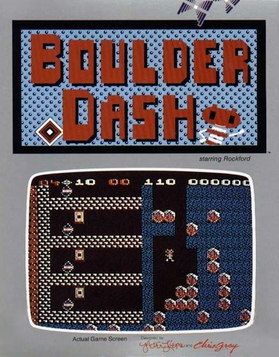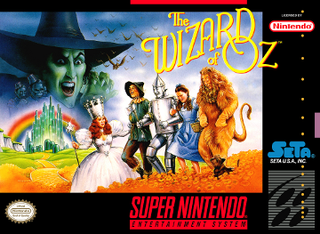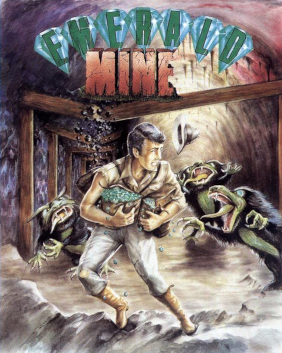
Boulder Dash is a maze-based puzzle video game released in 1984 by First Star Software for Atari 8-bit computers. It was created by Canadian developers Peter Liepa and Chris Gray. The player controls Rockford, who tunnels through dirt to collect diamonds. Boulders and other objects remain fixed until the dirt beneath them is removed, then they fall and become a hazard. Puzzles are designed around collecting diamonds without being crushed and exploiting the interactions between objects. The game's name is a pun on balderdash.

Turok: Dinosaur Hunter is a first-person shooter video game developed by Iguana Entertainment and published by Acclaim for the Nintendo 64 console and Microsoft Windows. It was released in 1997 in North America and Europe. Turok is an adaptation of the Valiant Comics comic book series of the same name. The player controls Turok, a Native American warrior, who must stop the evil Campaigner from conquering the universe with an ancient and powerful weapon.

Castlevania: Circle of the Moon, titled Castlevania in PAL regions, is a 2001 action role-playing game developed and published by Konami as a launch title for the Game Boy Advance. Part of the Castlevania video game series, the game follows a vampire hunter named Nathan Graves as he attempts to rescue his mentor from the clutches of Dracula. The events of its plot were retconned by former Castlevania producer Koji Igarashi, a move which was met with some criticism.

Moon Patrol is a 1982 arcade video game developed and released by Irem. It was licensed to Williams for distribution in North America. The player controls a Moon buggy which can jump over and shoot obstacles on a horizontally scrolling landscape as well as shoot aerial attackers. Designed by Takashi Nishiyama, Moon Patrol is often credited with the introduction of full parallax scrolling in side-scrolling games. Cabinet art for the Williams version was done by Larry Day. Most of the home ports were from Atari, Inc., sometimes under the Atarisoft label.
Thalamus Ltd was a British computer game developer that published titles for a number of 8-bit and 16-bit platforms during the late 1980s and early 1990s.

Harvest Moon 64, released in Japan as Bokujō Monogatari 2 (牧場物語2), is a 1999 farm simulation video game developed by Victor Interactive Software for the Nintendo 64 console. It was published by Victor Interactive in Japan and by Natsume Inc. in North America. It is the third game in the Story of Seasons series.

Star Wars: Rebel Assault is a 1993 rail shooter video game developed and published by LucasArts for DOS, Macintosh, Sega CD and 3DO Interactive Multiplayer systems, set in the Star Wars universe. It is the first CD-ROM-only game to be published by LucasArts. The game's story focuses on a young pilot called Rookie One as they are trained by, and subsequently fights for, the Rebel Alliance in the Galactic Civil War.

Dalek Attack is a 1992 computer game based on the long-running British science fiction television series Doctor Who, in which the player controls the Doctor and fights recurring adversaries, the Daleks and other enemies. In most versions of the game, the player can choose between playing as the Fourth, Fifth or Seventh Doctor; in the MS-DOS and Amiga versions, the player can play as the Second, Fourth or Seventh Doctor, and in the ZX Spectrum version only the Seventh Doctor was available. A second player may play as the Doctor's companion. K-9 also makes appearances later in the game as does Davros, creator of the Daleks in the TV series, as the final end of level boss. The game is set in London, Paris, New York, Tokyo and Skaro.

Jak and Daxter: The Precursor Legacy is a 2001 platform video game developed by Naughty Dog and published by Sony Computer Entertainment for the Sony PlayStation 2 on December 4, 2001, as the first game of the Jak and Daxter series. The game follows the protagonists, a young teenager named Jak, as he tries to help his friend Daxter after he is transformed into an "ottsel", a fictional hybrid of an otter and a weasel. With the help of Samos the Sage, a master of the mysterious energy called 'Eco' created by an ancient race known as the Precursors, the pair learn that they must save their world from the rogue sages Gol and Maia Acheron, who plan to flood the world with "Dark Eco", a mysterious substance which corrupts all it touches.

Chaos Island: The Lost World is a real-time strategy video game for the PC, developed and published by DreamWorks Interactive, and based on the 1997 film The Lost World: Jurassic Park. Chaos Island was released in North America on October 30, 1997. In Chaos Island, the player controls characters displayed on a map, directing where they move with the mouse and giving them commands either with the mouse or from a menu.

Star Wars: The Empire Strikes Back is the sequel to the vector graphics Star Wars arcade video game released by Atari, Inc. in 1983. It was made available by Atari Games in 1985 as a conversion kit for the original game. As in Star Wars, the player takes on the role of Luke Skywalker in a set of battle sequences from a first-person perspective. The game features the Battle of Hoth and the subsequent escape of the Millennium Falcon through an asteroid field. It is the third Star Wars arcade title from Atari; the raster game Return of the Jedi came out the previous year.

M.C. Kids is a 1992 platform video game developed and published by Virgin Games. It was initially released for the Nintendo Entertainment System in February 1992 in North America, and by Ocean Software in May 1993 in Europe. As a licensed product for the McDonald's fast food restaurant chain, the game stars two children named Mack and Mick who venture into the fantasy world of McDonaldland in order to return Ronald McDonald's magical bag which has been stolen by the Hamburglar. The game was created by four people in eight months: Darren Bartlett Gregg Iz-Tavares and Dan Chang (programming) and Charles Deenen (audio).

Predator is a 1987 side-scrolling action game based on the 1987 film Predator, and the first game based on the franchise.
SimCity is an open-ended city-building video game franchise originally designed by Will Wright. The first game in the series, SimCity, was published by Maxis in 1989 and was followed by several sequels and many other spin-off Sim titles, including 2000's The Sims, which itself became a best-selling computer game and franchise. Maxis developed the series independently until 1997, and continued under the ownership of Electronic Arts until 2003. EA commissioned various spinoffs from other companies during the 2000s, focusing on console and mobile releases. A 2013 EA-Maxis reboot was subject to what has been described as "one of the most disastrous launches in history", which may have triggered the 2015 shutdown of Maxis Emeryville and the end of the franchise.

Armalyte is a left-to-right scrolling shooter in the style of Gradius released for the Commodore 64 by Thalamus Ltd. It was marketed by Thalamus as the sequel to Delta, which was also a left-to-right horizontally scrolling shoot 'em up, but Delta was created by a different programming team.
Twilight Heroes is a browser-based, multiplayer role playing game designed and operated and released by American studio Quirkz Media in October 2007. In 2011, operation were subsequently taken over by Metroplexity Games.

The Wizard of Oz is a 1993 platform video game released for the Super Nintendo Entertainment System and loosely based on the 1939 film The Wizard of Oz. Developed by Manley & Associates, it was published by SETA Corporation and released in North America in 1993 and in Europe in 1994. The player assumes the role of Dorothy, the Scarecrow, the Tin Man, or the Cowardly Lion in a series of levels containing hidden areas, mazes, and puzzles to bring Glinda's magic ruby slippers to the Wizard of Oz.

Rupert and the Toymaker's Party is a video game developed by Martin Walker and published by Quicksilva in 1985. It was developed for the Commodore 64 and ZX Spectrum.

Alien Spidy is a platform game for Microsoft Windows, Macintosh, Xbox 360, and PlayStation 3. It was developed by Spanish studio Enigma Software Productions and published by Kalypso Media. Players control an extraterrestrial spider who has crash-landed on Earth, as he seeks to repair his spacecraft and rescue a fellow extraterrestrial spider.

Emerald Mine is a 1987 puzzle video game developed and published for Amiga and Atari ST by Kingsoft. The series follows mines filled with various gems, such as emeralds. It is a Boulder Dash clone in which the player completes levels by collecting sufficient gems before reaching the exit. Emerald Mine was Kingsoft's best-selling title with reviews generally favorable, and spawned several sequels. It was also Volker Wertich's, one of the game's designers, most successful game until The Settlers in 1993, of which he was also the creator.

















